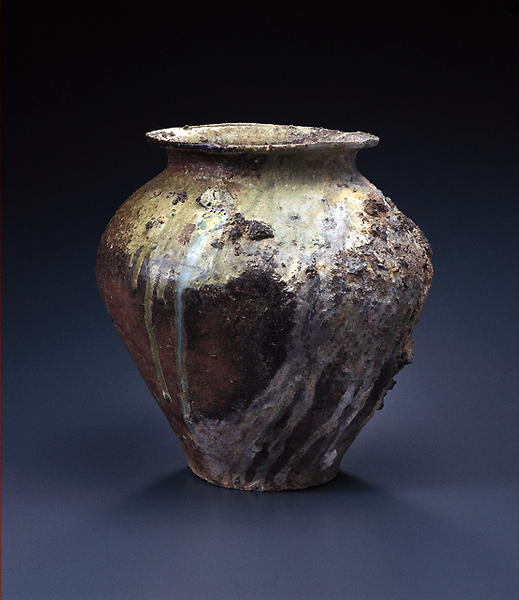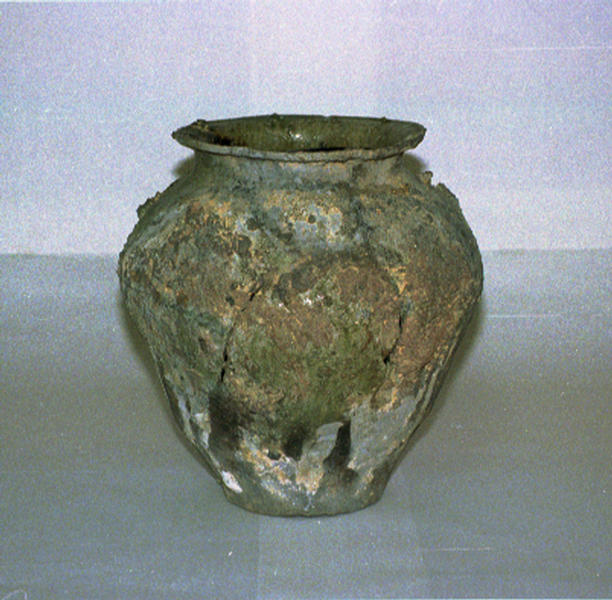常滑経甕
- 愛知県・常滑窯
- 平安時代後期
- 12c
- 自然釉陶製
- H-33.4 D-30
経塚造営の最盛期である十二世紀代を中心に、一般の甕とは別に経筒外容器として特別に作られた、常滑独特の器種である。この壺は常滑市北部に見られる黒土を用い、「よりこづくり」と呼ばれる紐作り成形されている。非常によく焼き締まっており、全体に茶褐色の火色が出ている。肩にかかった自然釉はよく溶けて濃緑色を呈し、その一部が胴下半にまで流れ落ちるようにかかっていて、力強い作品となっている。
平安時代後期 12世紀
高:33.4cm 口径:22.3cm 胴径:30.0cm 底径:15.0cm
平安時代後期の須恵器の中型甕の系譜を引く器形で,常滑窯の中心,すなわち,知多半島の中央部において,12世紀初頭から数多く焼かれた常滑独特の器種である。経塚造営の最盛期である12世紀代を中心に,一般的な甕とは別に経筒外容器として特別に作られたものと考えられ,その大きさはほぼ決まっており,全国の経塚からの出土例は極めて多い。内部に納めた経文や経筒に年号を記したものも多く知られていて,その形態から見て,作られた年代を比較的容易に知ることができる。この経甕は常滑市東・北部に多く見られる黒土(鉄分の多い粘土)を用いて,紐作り成形されたもので,常滑では「よりこづくり」と呼ばれる手法である。口縁部の先端にある程度面取りを施している点や肩の張り具合から見て12世紀後半の作と考えられる。
この作品は非常によく焼き締まっていて,全体に茶褐色に火色が出ており,肩に掛かった自然釉がよく溶けて濃緑色を呈し,その一部が胴下半にまで流れ落ちるように掛かっていて,力強い作品になっている。(楢崎)
常滑窯(とこなめ)
愛知県知多半島に分布する中世に始まる一大窯業地です。1000基以上の窯跡があり、12~16世紀にかけて壺、甕、鉢などを大量に生産しました。その商圏は太平洋沿岸を中心に北は青森から南は種子島にまで及んでいます。
常滑自然釉壺
経甕(きょうがめ)
経塚壺ともいいます。平安時代後期に末法思想が広まり、釈迦が弥勒として再生するまで経典を埋蔵しようとする信仰が盛んになりました。経塚はこの経典埋蔵のための遺構で、鎌倉から室町時代にかけて行われました。その外容器のひとつとして中世の常滑の壺などが使われました。
よりこづくり(撚子づくり)
「よりこ」とは常滑地方で用いられていることばで、壺や甕を紐づくりする時の粘土の紐のこと。粘土を棒状に台の上でねるのでよりこと呼びました。よりこづくりは台の上で回しながらよりこを積み上げて甕などを形づくっていく成形法。常滑の紐づくりは大型のものが多く、紐というよりも棒といえるほどの太さがあります。
常滑自然釉壺
Catalogue Entry
Late Heian period, 12th century
Tokoname ware, natural ash glaze
Height, 33.4cm; mouth diameter, 22.3cm;
torso diameter, 30.0cm; base diameter, 15.0cm
This form of jar was a continuation of the medium-sized Sue ware jars of the late Heian period and became a distinctive shape of the Tokoname kilns, with large numbers of these jars fired at the beginning of the 12th century in the Tokoname kilns in the center of the Chita peninsula. The 12th century was at the height of the production of sutra burial mounds, and generally this shape of jar is thought to have been made specifically as an exterior container for sutra cases, as opposed to the standard use of such jars. The size of these jars was thus relatively determined by the size of the interior sutra containers, and an extremely large number of these jars have been excavated from sutra mounds throughout Japan. Many of these jars were found with dated sutras or inner sutra containers, and thus a dating system based on the shapes found with each date has been relatively easily devised. This sutra container is made of a black clay (high iron content clay) that is commonly found in the northern section of present-day Tokoname city, and it is a coil-built form. This method of hand-building is called yorikozukuri at Tokoname. The relatively wide lip edge and the swell of the shoulders indicate a production in the latter half of the 12th century.
This work is extremely well-fired with an overall brown fire-color and a thick flow of natural ash glaze in a dark green color across the shoulders. A section of this natural glaze flows to the lower half of the jar, giving a particularly strong appearance to the work. SN

